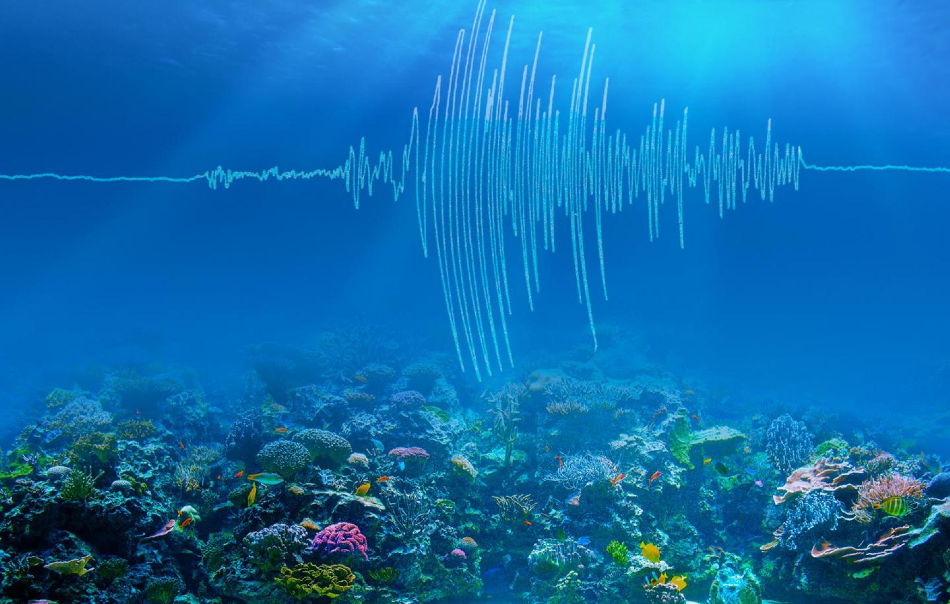Sep 21 2020
Although climate change is most evident to people in the form of melting glaciers or unseasonably warm winter days, around 95% of the additional heat trapped on Earth by greenhouse gases is retained in the global oceans.

An artist’s rendering of undersea earthquake waves. Image Credit: California Institute of Technology.
Due to that reason, tracking the temperature of ocean waters has been a top priority for climate scientists, and at present, scientists from the California Institute of Technology (Caltech) have found that seismic rumblings on the seafloor can offer them another tool for doing just that.
In a new article published in the Science journal, the team has described how they were able to use present-day seismic monitoring equipment, and also historic seismic data, to establish the amount of the temperature of the Earth’s oceans that has changed and continues to change, even at depths that are usually beyond the reach of traditional tools.
The researchers do this by listening for the sounds from the several earthquakes that often take place under the ocean, stated Jörn Callies, the study’s co-author and assistant professor of environmental science and engineering at Caltech.
Callies added that the sounds of these earthquakes are very powerful, and move long distances via the ocean without considerably weakening, which renders them easy to track.
Sound and Ground Waves
Wenbo Wu, the lead author of the study and a postdoctoral scholar in geophysics, explained that when an earthquake takes place under the ocean, a large part of its energy travels via the earth, but a part of that energy is also transmitted into the water in the form of sound.
Sound waves like these propagate externally from the epicenter of the earthquake, similar to the seismic waves traveling via the ground; however, the sound waves travel at a relatively lower speed.
Consequently, ground waves will reach a seismic tracking station first, and this is followed by the sound waves, which will emerge as a secondary signal of the same event. Such an effect is approximately analogous to how the flash from lightning is seen seconds before its thunder is heard.
These sound waves in the ocean can be clearly recorded by seismometers at a much longer distance than thunder—from thousands of kilometers away. Interestingly, they are even 'louder' than the vibrations traveling deep in the solid Earth, which are more widely used by seismologists.
Wenbo Wu, Study Lead Author and Postdoctoral Scholar in Geophysics, California Institute of Technology
In water, the speed of sound increases as the temperature of the water also increases; hence the researchers realized that the duration of time taken by a sound to travel a specified distance in the ocean can be utilized to infer the temperature of the water.
The key is that we use repeating earthquakes—earthquakes that happen again and again in the same place. In this example we're looking at earthquakes that occur off Sumatra in Indonesia, and we measure when they arrive in the central Indian ocean. It takes about a half hour for them to travel that distance, with water temperature causing about one-tenth-of-a second difference. It's a very small fractional change, but we can measure it.
Wenbo Wu, Study Lead Author and Postdoctoral Scholar in Geophysics, California Institute of Technology
Wu added that since the team is utilizing a seismometer that has been in the same site in the central Indian Ocean from 2004, they can review the data it gathered each time an earthquake took place in Sumatra, for instance, and thus establish the temperature of the ocean simultaneously.
We are using small earthquakes that are too small to cause any damage or even be felt by humans at all. But the seismometer can detect them from great distances, thus allowing us to monitor large-scale ocean temperature changes on a particular path in one measurement.
Wenbo Wu, Study Lead Author and Postdoctoral Scholar in Geophysics, California Institute of Technology
Callies added that the data analyzed by the team prove that the Indian Ocean has been warming, as indicated by other data obtained through other techniques, but that it might be warming even quicker than earlier estimated.
According to Callies “The ocean plays a key role in the rate that the climate is changing. The ocean is the main reservoir of energy in the climate system, and the deep ocean in particular is important to monitor. One advantage of our method is that the sound waves sample depths below 2,000 meters, where there are very few conventional measurements.”
Based on which set of earlier data was used by the researchers to compare their results, ocean warming seems to be as much as 69% greater than had been believed before. But Callies warns against drawing any quick conclusions, because more data needs to be gathered and investigated.
Since undersea earthquakes take place globally, Callies added that the system developed by him and his fellow scientists could be extended to track the water temperatures in all the oceans. Wu added that since the method uses existing equipment and infrastructure, it is comparatively affordable.
“We think we can do this in a lot of other regions, And by doing this, we hope to contribute to the data about how our oceans are warming.” Callies concluded.
The article describing the study, titled, “Seismic Ocean Thermometry,” appeared in the September 18th issue of Science. The study’s co-authors are Wenbo Wu, a postdoctoral scholar in geophysics; Zhongwen Zhan (PhD '13), assistant professor of geophysics; and Shirui Peng, a graduate student in environmental science and engineering, all from Caltech; and Sidao Ni (MS '98, PhD '01) from the Institute of Geodesy and Geophysics at the Chinese Academy of Sciences.
Journal Reference
Wu, W., et al. (2020) Seismic ocean thermometry. Science. doi.org/10.1126/science.abb9519